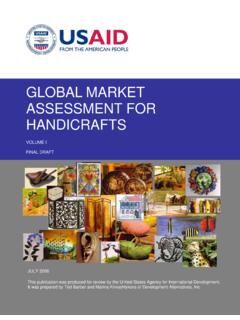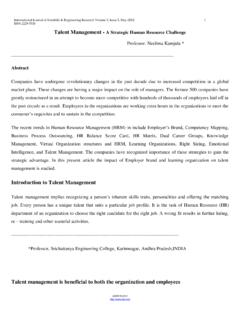Transcription of 6. A guide to Mergers and Acquisitions in the UK
1 6. A guide to Mergers and Acquisitions in the UK. Mergers & Acquisitions (M&A) are becoming increasingly popular for the aspiring foreign company wanting to invest in the UK. Business growth can be achieved in a variety of ways. Organic expansion through marketing and business development is perhaps the most conventional option, but it may not be the fastest. In addition, growing organically in overseas markets is challenging where local customs, rules and regulations are not fully understood. One, often quicker option, that can avoid the challenges of setting up in a new market, is to either invest in, or buy outright, a business operating in the market of interest. Today, Acquisitions of Western businesses by overseas (buyers are at an all time high, and levels are growing. Foreign companies may undertake M&A for a variety of reasons, including obtaining brands and intellectual property, market access, and market knowledge. Foreign companies are becoming increasingly confident in their ability to finance and execute deals.)
2 And foreign private equity acquirers, those who buy in to a company primarily as an investment rather than as an addition to their existing business, are becoming more established. Despite the growing volume and value of deals, M&A transactions are not without risks, and proper advice should be sought when contemplating this option. This chapter sets out some of the key considerations. In each of these areas, Deloitte has a specialist team available to assist. M&A strategy In considering whether M&A is the appropriate method to improve shareholder value, performance and market competitiveness, a company should first review its corporate strategy. Corporate strategy makes the company greater than the sum of its business units, and sets out the organisation's direction and goals, business portfolio, resource allocation and growth plans. A corporate strategy review is critical for success , yet is often neglected by executives under pressure to achieve short term results. One of the primary causes for acquisition failures is a lack of insight into the target company, its core competencies and limitations, and changing market conditions.
3 The rigorous analysis conducted in a strategy review enables a company to understand its internal strengths and external market conditions, both in its home country and overseas, over the coming few years. This analysis helps to develop a set of prioritised options, such as an acquisition or divestment, to achieve its objectives. Investing in the UK A guide for South African businesses 55. As challenges and opportunities for growth are defined, options to defend, grow, fix or exit can be assessed and prioritised based on the company's goals, capabilities and financial position. Generally, companies can choose from a myriad of strategic objectives such as: profitable growth to increase business breadth or depth through revenue growth, market share capture, margin enhancement or improved asset utilisation;. skill strengthening to acquire the necessary talent to remain competitive ( personnel, technology, capability, geographies, etc.);. portfolio management to manage a portfolio of businesses in order to maximise existing and evolving capabilities, reduce risk, or reposition a business.
4 Defensive action to ward off potential take-over attempts or fix existing business/operational problems;. opportunistic posture to capitalise on a unique market/competitive opportunity or a developing business formula; and globalisation to expand market share and sales in international venues. Depending on a company's strategy, Acquisitions may serve as a way to quickly achieve strategic and financial objectives. Target sourcing and selection Once the company has determined that an acquisition fits with its wider corporate strategy, the next phase is to identify potential targets, synergy opportunities and to arrive at a valuation. Developing a pool of targets In assessing investment opportunities, a company should evaluate the attractiveness of the sector in which it plans to conduct an acquisition by: nnderstanding the industry structure and leverage points, where value can be captured;. appreciating the market scale, and growth potentials;. understanding the key players, both domestic and foreign-owned, along with competitive dynamics.
5 Envisaging any technological trend; and identifying entry barriers. Once the decision is made to pursue opportunities in a sector, the company can begin its preliminary research on potential acquisition candidates. Investing in the UK A guide for South African businesses 56. Developing the acquisition candidate pool The first step in a target selection process is to develop a long list of potential acquisition candidates. This involves a high-level search based on criteria such as: Sector/industry. Competitive position within the industry/product mix. Revenue/size. Market capitalisation. Location of operations. Often a search will come up with more than 100 potential candidates in the long list. These potential candidates will be further screened and profiled. Sourcing potential acquisition candidates Finding the right candidate, a buyer or a seller, requires time and patience. A search for a target requires an extensive review of potential candidates before finding one that fits a company's strategic needs, whilst being fairly priced.
6 A company could identify potential acquisition targets by conducting internal analysis or using its own network. Some business owners would search openly for a buyer whilst others would identify potential candidates through: examining the financial position of potential companies. Financial problems such as cash shortages or excessive debt may indicate that a sale may be necessary; and investigating the potential company's shareholding and management. Indications of possible future sales include an owner nearing retirement with no heirs in key management positions, absentee owners, or financial investors potentially interested in an exit strategy. Defining screening criteria The criteria used for the screening process should be developed based on corporate objectives and may include: (i) Strategic and financial criteria affordability potential acquisition targets are reviewed in terms of market capitalisation, revenues, net assets value;. profitability targets' EBITDA/EBIT, net margin and free cashflow.
7 Investing in the UK A guide for South African businesses 57. shareholding preferences determining the desired level of control over the target and defining a criteria for either a majority or a minority shareholding;. transaction structure preferences acquisition of shares against assets; and management requirements taking into consideration leadership style, expertise, receptivity to change, compatibility of culture, and modality of management after the completion of the transaction. (ii) Operational marketing criteria: product lines, customer base, brand reputation, geographic area, distribution channels;. research & development requirements: licences, patents, research & development centres, product pipeline, research & development expenses; and production criteria, such as facilities, labour supply, production techniques and capacity. Short-listed targets should be further screened to determine: their fit into the buyer's current business portfolio;. their competitive position and future prospects; and the value they create for the buyer.
8 (iii) Collecting target data Availability of target data in the UK is generally good. UK companies have to file publicly available financial statements on an annual basis. These must be audited wherever a company exceeds certain size limits. For listed or quoted companies, more regular reporting is required and information may be available from investment analyst coverage. (iv) Prioritising targets Buyers should prioritise potential targets according to the number of screening criteria the target companies fulfil. This is also an opportunity to establish under what circumstances the company would walk away from one target and move on to the next. Prior to approaching the target company, additional research and information gathering should be conducted by a financial advisor to provide a more complete picture of the candidate. This would include information on ownership and management teams in the target companies, and include subjective elements such as family situations and succession plans ( the willingness of children to take over the business).
9 Very often, negotiation levers are identified during this process. Investing in the UK A guide for South African businesses 58. An experienced lead advisor will: assist in prioritising the targets;. develop appropriate strategies and tactics to approach the targets;. prepare appropriate Confidentiality and Exclusivity Agreements; and develop the right time frame for negotiations and due diligence. (v) Synergy expectations The synergies available can be significant and are often the reason for the acquisition . Synergies can be difficult to quantify and their capture is uncertain. It is therefore essential that they are considered carefully throughout the M&A process. An initial part of due diligence is identifying potential synergy opportunities between targets and the buyer. Only targets that bring additional value to a company should be considered in an M&A exercise. A synergy may be defined as the increase in performance of the combined company over what the two companies are already expected or required to accomplish as independent companies.
10 Put simply, synergy is either the revenue enhancing or cost savings achieved by integrating. Revenue enhancing synergies. A revenue enhancing synergy results in additional revenue above and beyond what the two companies are expected to accomplish independently. Revenue enhancements promote higher returns and facilitate long-term growth more than cost savings, but they tend to be difficult to quantify. Most initiatives that can enhance revenue can be grouped into: market expansion: Entering new markets and expanding market share;. margin improvement , by implementing a better pricing strategy;. asset utilisation: Enhanced performance through better and more efficient use of existing assets;. investments: Better return on investment (ROI) on existing investments. For example, the acquiring company has an extensive IT infrastructure which the target company can also access; and products and services: Increasing product portfolios and service portfolios by creating better product mixes, or removing a potential substitution option.















